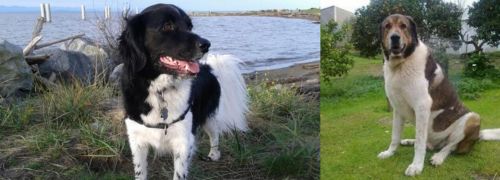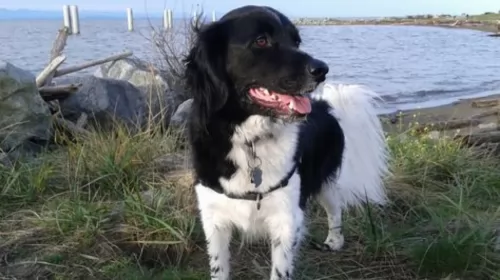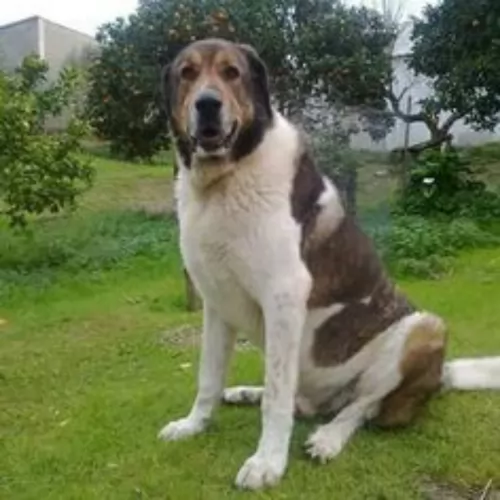 MyDogBreeds
MyDogBreeds Stabyhoun is originated from Denmark but Cao de Gado Transmontano is originated from Portugal. Stabyhoun may grow 30 cm / 11 inches shorter than Cao de Gado Transmontano. Stabyhoun may weigh 15 kg / 33 pounds lesser than Cao de Gado Transmontano. Stabyhoun may live 3 years more than Cao de Gado Transmontano. Both Stabyhoun and Cao de Gado Transmontano has almost same litter size. Both Stabyhoun and Cao de Gado Transmontano requires Low maintenance.
Stabyhoun is originated from Denmark but Cao de Gado Transmontano is originated from Portugal. Stabyhoun may grow 30 cm / 11 inches shorter than Cao de Gado Transmontano. Stabyhoun may weigh 15 kg / 33 pounds lesser than Cao de Gado Transmontano. Stabyhoun may live 3 years more than Cao de Gado Transmontano. Both Stabyhoun and Cao de Gado Transmontano has almost same litter size. Both Stabyhoun and Cao de Gado Transmontano requires Low maintenance.
 The Stabyhoun is a near extinct breed and one of the rarest ever. He was never recognized by the major kennel clubs but was entered into Foundation Stock Services.. The breed comes from the Netherlands in the Frisian Forest and has been known since the early nineteenth century.
The Stabyhoun is a near extinct breed and one of the rarest ever. He was never recognized by the major kennel clubs but was entered into Foundation Stock Services.. The breed comes from the Netherlands in the Frisian Forest and has been known since the early nineteenth century.
It was not known outside of the Friesland Forest area until the 1960’s and outside the Netherlands only since the twenty first century. The Stabyhoun is a Dutch national treasure whose name means “stand by me dog”. Today throughout the world only a few thousand remain.
The Stabyhoun is hunter and retriever with a soft-mouth and ability to point. He was used for duck hunting and finding upland birds. He is great in the water, sharp-eyes and efficient, he works quickly. The breed has also been known to hunt fox, other birds and small game. They are great at catching moles.
Even though British breeds are more popular for hunting now, the Stabij remains an excellent all round hunter. He can track, point, and retrieve. He is also a good watchdog though his disposition is peaceful and gentle. They needed to be general all around farm dogs as farmers could only afford one dog.
They have not changed much since the 1800’s either in function or appearance. In order to get such a gentle working dog, they early Stabyhoun has been mixed with the much older and rarer breed from the same area, the Wetterhoun. This crossbreeding was stopped in 1942 in order to gain breed recognition and hope to keep either of these two rare breeds from extinction.
Today the number of Stabyhoun in the Netherlands, the United Kingdom, North America and Scandinavia are slowly but surely increasing. He is highly prized as an independent thinker and hunter, inquisitive and gentle. They are related to the Heidewachtel and the Drentsche Patrijshound.
The first Staby born in the U.S. was around 1994 and in 2017 there were thought to be over 7000 Stabyhouns in the world. They are much more popular now in Europe and North America.
 The Cão de Gado Transmontano which is also known as the Transmontano Mastiff or Transmontano Cattle Dog is a large dog – in fact a giant dog breed. This is a rare molosser working dog, hailing from the region of Tras-os-Montes e Alto Douro Province in Portugal.
The Cão de Gado Transmontano which is also known as the Transmontano Mastiff or Transmontano Cattle Dog is a large dog – in fact a giant dog breed. This is a rare molosser working dog, hailing from the region of Tras-os-Montes e Alto Douro Province in Portugal.
The large dog has always been used to herd livestock and to also ward off wolves. It is believed that the dog’s roots come from the Tibetan Mastiff as well as a Portuguese cattle dog known as the Rafeiro do Alentejo. The dog also shares some similarities with the short-haired Estrela Mountain Dog.
In 1995 the breed was still exclusive to Portugal, but now the breed has been imported to Oregon, USA to be part of an experiment to document bigger breeds and their role in protecting livestock from wolves. They were re-introduced to north-east Oregon from 2008.
 The Staby are powerful soft-mouthed pointers who are not too fine or too robust with tightly fitting skin. Their chest, legs, collar and tail are feathered and make the dog look like a longhaired canine, but she really is not. The dog is longer than it is tall, and his head is longer than it is wide. Most of the breed are black and white but there are many brown and white, while the orange and white are very close to extinction.
The Staby are powerful soft-mouthed pointers who are not too fine or too robust with tightly fitting skin. Their chest, legs, collar and tail are feathered and make the dog look like a longhaired canine, but she really is not. The dog is longer than it is tall, and his head is longer than it is wide. Most of the breed are black and white but there are many brown and white, while the orange and white are very close to extinction.
They have a slightly domed skull and a slightly arched but strong neck. Their muzzle is broad and the bridge straight while the nose is well developed. With medium sized ears, set low on the head and having the bottom third of the ears covered with hair. The eyes are round, medium sized and level in the head
They have a long sleek coat with a slightly wavy croup. They are never curly. Its back is straight, tail long and loin powerful.
 The Cão de Gado Transmontano is a large dog, believed to be the biggest of the Portuguese dog breeds. He is powerful and muscular with a large head and can stand up to 83cm in height and can weigh up to 65kg.
The Cão de Gado Transmontano is a large dog, believed to be the biggest of the Portuguese dog breeds. He is powerful and muscular with a large head and can stand up to 83cm in height and can weigh up to 65kg.
He is tough, and is quite comfortable living outside. He is a long-legged dog with a wide chest with medium length floppy ears and a long tail. The coat is fairly short although it can be in a variety of lengths. It is the medium length coated dog with the right coloring that is looked upon as a pure breed. The dog is white with large patches of brown, fawn, grey, brindle and black shades.
The Transmontano Mastiff is an intelligent, obedient dog who is also independent and stubborn. As with all dogs, it is important to have him trained and socialized as this makes him obedient and eager to please. He loves to be patted by his owners and is a dog which is easy to train, responding well to firmness and fairness.
He is calm and somewhat docile but at the same time he is energetic and alert, making him a good watchdog. He won’t do well cooped up in a tiny space. He gets on well with children and other pets in the home.
 The Cão de Gado Transmontano may look like a fairly formidable dog but they aren’t aggressive. They are full of courage and are above all, loving and loyal to their human family.
The Cão de Gado Transmontano may look like a fairly formidable dog but they aren’t aggressive. They are full of courage and are above all, loving and loyal to their human family.
When you choose to have one of these large dogs as your pet, it is important to make sure he knows that you’re the leader. With training and socialization this dog is a gentle giant who makes an exceptional family pet.
 Though an isolated, rare breed for so long, the Stabyhoun does have several known health issues including:
Though an isolated, rare breed for so long, the Stabyhoun does have several known health issues including:
• PDA or Patient Ductus Arteriosis – heart issue from 6 weeks on. Major vessel does not close. With surgery it can be corrected.
• Type 1 von Willebrand’s Disease (vWB) – a bleeding disorder in its mildest form. DNA testing is available not required.
• Cerebral dysfunction – rare compulsive behavior at 6 weeks. It is fatal at this point. DNA testing will be required.
 The Cão de Gado Transmontano is a tough dog, used to spending long hours outside guarding sheep. These days however, he is also a companion dog and you’ll want to be aware of some common dog ailments that can strip him of his health and his joy of life.
The Cão de Gado Transmontano is a tough dog, used to spending long hours outside guarding sheep. These days however, he is also a companion dog and you’ll want to be aware of some common dog ailments that can strip him of his health and his joy of life.
Hip Dysplasia is a looseness with the hip joint, and while it can occur with all dogs, it is more common in large dogs. It’s a disease which can lead to arthritis, pain and also joint degeneration. It’s a disease which can be debilitating for the dog and you will need to get your dog to the vet.
This is a heart disease seen in large breed dogs and where the heart becomes weak and can’t properly pump blood throughout the body. Symptoms include coughing, weakness, difficulty with breathing as well as a fluid-distended abdomen.
 1Feeding the puppy -They are prone to obesity. Do not overfeed. Watch calories. Feed a high quality dog food meant for active medium sized dogs in 3-4 meals per day.
1Feeding the puppy -They are prone to obesity. Do not overfeed. Watch calories. Feed a high quality dog food meant for active medium sized dogs in 3-4 meals per day.
2.Feeding the adult – Feed a high quality dog for medium sized dogs in 2-3 meals per day.
An active dog that needs exercise. They need mental stimulation as much or more than they need physical. Don’t skimp on either. They love agility, field trials, lure coursing, and scent training. They also love the triathlon, frisbee and endurance.
 Just because this is a large dog, doesn’t mean you need to over-feed him. He is muscular and athletic, and by watching his diet, he’ll continue to be strong, lean and healthy. You can feed him a top quality pet-food brand and include boiled chicken, rice and vegetables. Every now and then mix in some raw meat with his dog food to ensure that his skin remains free of rashes and itchiness. Fresh, cool water must be available to him day and night as he drinks abundantly.
Just because this is a large dog, doesn’t mean you need to over-feed him. He is muscular and athletic, and by watching his diet, he’ll continue to be strong, lean and healthy. You can feed him a top quality pet-food brand and include boiled chicken, rice and vegetables. Every now and then mix in some raw meat with his dog food to ensure that his skin remains free of rashes and itchiness. Fresh, cool water must be available to him day and night as he drinks abundantly.
Some dog breeds need to be trimmed or stripped to look good, and dog owners often invest in expensive equipment to groom their pets themselves, Fortunately the large Cão de Gado Transmontano is a low maintenance dog and all you’ll need to do is give him a good brush-down twice a week.
Check his eyes, ears, teeth and nails regularly. Remember that dental hygiene is imperative and special canine toothbrush and toothpaste is available to brush your dog’s teeth 2 or 3x a week to get rid of plaque and to prevent gum disease and tooth decay.